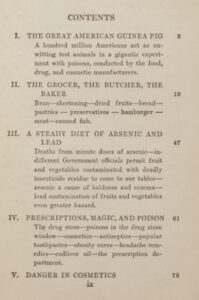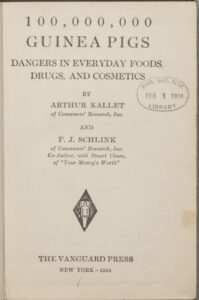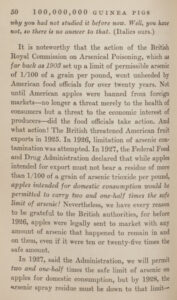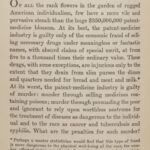Variously praised as a major exposé and criticized as unfounded sensationalism, this wake-up call to American consumers, describing the harmful chemicals found in products they used every day, was a bestseller when it was published. Who could resist such thought-provoking chapter titles as “A Steady Diet of Arsenic and Lead,” “Prescriptions, Magic, and Poison,” and “The Quack and the Dead”?
The MIT community certainly couldn’t resist. The Libraries accessioned this book on 1 February 1934. Very little time had passed since its publication, and interest in the title hadn’t waned. Our copy’s date-due slip is covered with stamps, the earliest dating back only to 1939 – indicating that it’s a replacement for an earlier date-due slip (or slips) that had likewise been filled up. There’s no telling how many times this book was checked out prior to 1939.
Meanwhile, it seems little has changed since 1933, if indeed things haven’t gotten worse. The authors have nothing kind to say about the products in the grocer’s typical delivery:
Because of them, out of the pockets of America’s Joneses and Smiths and Browns will come, during the next year, a hundred million dollars or so for medicines and doctor bills and time lost from work; a few hundred thousand members of the Jones families will suffer from obscure stomach, intestinal and kidney ailments; a hundred thousand Grandfather Smiths will die from five to ten years sooner than they would otherwise have died; and some thousands of Browns will succumb to tuberculosis contracted in the first place from contaminated food.
 Replace “a hundred million dollars” with billions of dollars, perhaps “tuberculosis” with any number of 21st century maladies, and you’ll approximate the scope of the chemical food crisis which, many people claim, still plagues us today.
Replace “a hundred million dollars” with billions of dollars, perhaps “tuberculosis” with any number of 21st century maladies, and you’ll approximate the scope of the chemical food crisis which, many people claim, still plagues us today.
Whether the authors’ claims are fact or fiction – and experience seems to suggest that it’s a combination of the two – it’s no mere coincidence that the landmark Federal Food, Drug, and Cosmetic Act was passed in 1938. The FFDCA is considered, at least in part, to be the result of public attention generated by this book and by others like it.



